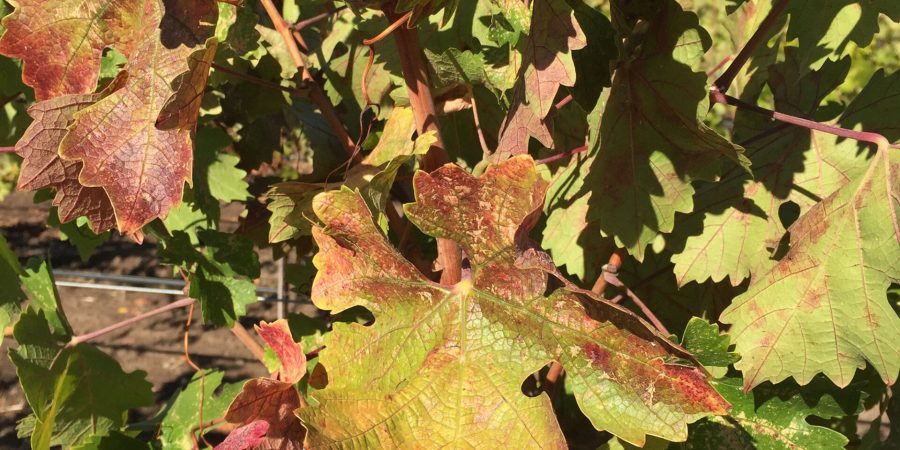The wine industry here in Australia got some not-so-great news last week…
For the first time ever Grapevine Red Blotch Virus (GRBV) has been detected as a result of routine screening for a range of viruses and follow-up tracing.
So far it has only been detected in grapevine germplasm collections in Victoria, South Australia and Western Australia.
While collections are used for propagation, the virus has thankfully not been discovered in commercial nurseries or vineyards.
Its detection is cause for alarm though. GRBV is classified as a “High Priority Plant Pest” for the viticulture industry. That means it has the potential to have a very serious impact on the industry.
Here are all the details of the detection here in Australia…
- One table grape variety and six wine grape variety/clone combinations have tested positive.
- Traceback activities show that GRBV likely entered Australia in infected propagation material as early as 1985. That was well before the virus was discovered or a diagnostic test developed.
- Trace forward activities are in progress to confirm the extent of the spread.
- Long-distance spread of the virus is primarily through infected propagation material, including grafting.
- Insect vectors (three-cornered alfalfa hopper) have been implicated in short-distance spread of the virus in North America.
Fortunately, that insect doesn’t currently exist in Australia, which could be preventing transmission.
While there’s no cause for panic, eradication is essential.
What is Grapevine red blotch virus?
Grapevine red blotch virus is a single-stranded DNA virus.
It is the causal agent of red blotch disease that was first reported in the Napa Valley, California in 2008. Although, due to its similarity to another disease (leafroll virus) it is thought to have been present for decades.
Initially, GRBV was only known to occur in the US, but has since been reported in Switzerland, Republic of Korea, Mexico, India, Canada, Argentina and most recently Italy.
The virus has been found alone and in combination with other viruses.
It affects common red and white winegrape varieties, table grapes and some rootstocks. GRBV has been detected in grapevine collections, nursery stock and established vineyards – both young and mature.
Loving our blog? Sign up for weekly updates straight to your inbox…
[withwine type=’join-mailing-list’]
Symptoms
Red blotch disease symptoms affect both the leaves and the fruit.
Foliar symptoms:
- In red varieties where symptoms are more pronounced, the disease causes leaves to become red and blotchy with marginal reddening and red veins.
- In white varieties, foliar symptoms include irregular chlorotic and yellowing of leaves which can turn necrotic later in the season.
- Compromised photosynthesis in that vines cannot conduct water effectively, leaving sugars stuck in the leaves rather than accumulating in the berries.
Fruit symptoms:
- Consistently delayed ripening – some bunches never fully mature and bunches with reduced sugar content (by up to 1-2˚ baume), poor colour development and increased malic acid.
- Impacts of the virus on anthocyanins, tannins, phenolics and the resultant flavour profile and mouthfeel. This has dramatically reduced winegrape value in California. These effects are greater on red varieties.
- Bunch weight may be reduced, but much is still unknown about impacts on yield by variety and rootstock.
Transmission
The most common form of GRBV spread is through human-assisted spread of infected propagation material.
The Three-Cornered Alfalfa Hopper has been shown by researchers to transmit the virus in an experimental vineyard, despite not being a grape pest.
However, due to the random nature of infection, researchers are now considering that other arthropod species are possibly vectoring GRBV.
What next?
There is an organisation called the National Consultative Committee for Emergency Plant Pests that links the Commonwealth, states and territories and industry into early decision-making regarding plant pests.
They’ll be getting notifications from Government on the incident as new information becomes available.
Australian Grape and Wine is the winegrape industry’s representative on this committee.
They’ll be working closely with state government biosecurity departments to understand where the virus is in Australia through tracing and testing, and thus determine the potential impact for industry including for the propagation sector.
Fingers crossed they get on top of it before it becomes a thing here in Australia.
Some better news!
Last week, I alluded to the fact that Rob has been going through his cellar. He’s found some goodies in there that he’s willing to share with you (we did have to give him a little bit of gentle encouragement!).
So, if I were you, I would be keeping a close eye on your email for an announcement this weekend!
